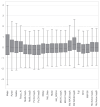A Haplotype-resolved, Chromosome-scale Genome for Malus domestica Borkh. 'WA 38'
- PMID: 39288023
- PMCID: PMC11631450
- DOI: 10.1093/g3journal/jkae222
A Haplotype-resolved, Chromosome-scale Genome for Malus domestica Borkh. 'WA 38'
Abstract
Genome sequencing for agriculturally important Rosaceous crops has made rapid progress both in completeness and annotation quality. Whole genome sequence and annotation gives breeders, researchers, and growers information about cultivar specific traits such as fruit quality and disease resistance, and informs strategies to enhance postharvest storage. Here we present a haplotype-phased, chromosomal level genome of Malus domestica, 'WA 38', a new apple cultivar released to market in 2017 as Cosmic Crisp®. Using both short and long read sequencing data with a k-mer based approach, chromosomes originating from each parent were assembled and segregated. This is the first pome fruit genome fully phased into parental haplotypes in which chromosomes from each parent are identified and separated into their unique, respective haplomes. The two haplome assemblies, 'Honeycrisp' originated HapA and 'Enterprise' originated HapB, are about 650 Megabases each, and both have a BUSCO score of 98.7% complete. A total of 53,028 and 54,235 genes were annotated from HapA and HapB, respectively. Additionally, we provide genome-scale comparisons to 'Gala', 'Honeycrisp', and other relevant cultivars highlighting major differences in genome structure and gene family circumscription. This assembly and annotation was done in collaboration with the American Campus Tree Genomes project that includes 'WA 38' (Washington State University), 'd'Anjou' pear (Auburn University), and many more. To ensure transparency, reproducibility, and applicability for any genome project, our genome assembly and annotation workflow is recorded in detail and shared under a public GitLab repository. All software is containerized, offering a simple implementation of the workflow.
Keywords: Malus domestica ‘WA 38’; Apple genomics; comparative genomics; genome annotation; genome sequence; haplotype-resolved assembly; plant genomics.
© The Author(s) 2024. Published by Oxford University Press on behalf of The Genetics Society of America.
Conflict of interest statement
Figures









References
-
- Andrews S. 2020. FastQC: a quality control tool for high throughput sequence data. Retrieved November, 2024. [Online]. http://www.bioinformatics.babraham.ac.uk/projects/fastqc/.
-
- Chen X, Li S, Zhang D, Han M, Jin X, Zhao C, Wang S, Xing L, Ma J, Ji J, et al. . 2019. Sequencing of a wild apple (Malus baccata) genome unravels the differences between cultivated and wild apple species regarding disease resistance and cold tolerance. G3 (Bethesda). 9(7):2051–2060. doi:10.1534/g3.119.400245. - DOI - PMC - PubMed
LinkOut - more resources
Full Text Sources
Miscellaneous
